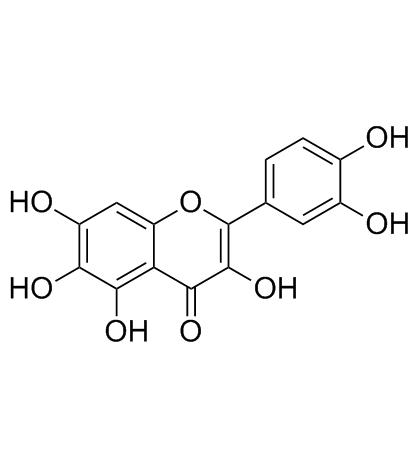3,3',4',5,6,7-HEXAHYDROXYFLAVONE
Modify Date: 2024-01-09 22:26:51

3,3',4',5,6,7-HEXAHYDROXYFLAVONE structure
|
Common Name | 3,3',4',5,6,7-HEXAHYDROXYFLAVONE | ||
|---|---|---|---|---|
| CAS Number | 90-18-6 | Molecular Weight | 318.23500 | |
| Density | 1.912 g/cm3 | Boiling Point | 732.4ºC at 760 mmHg | |
| Molecular Formula | C15H10O8 | Melting Point | >300ºC | |
| MSDS | N/A | Flash Point | 280.3ºC | |
Use of 3,3',4',5,6,7-HEXAHYDROXYFLAVONEQuercetagetin (6-Hydroxyquercetin) is the major flavonoid isolated from Citrus unshiu (C. unshiu) peel[3]. Quercetagetin is a moderately potent and selective, cell-permeable pim-1 kinase inhibitor (IC50, 0.34 μM)[1]. Anti-inflammatory and anticancer properties. |
| Name | quercetagetin |
|---|---|
| Synonym | More Synonyms |
| Description | Quercetagetin (6-Hydroxyquercetin) is the major flavonoid isolated from Citrus unshiu (C. unshiu) peel[3]. Quercetagetin is a moderately potent and selective, cell-permeable pim-1 kinase inhibitor (IC50, 0.34 μM)[1]. Anti-inflammatory and anticancer properties. |
|---|---|
| Related Catalog | |
| Target |
PIM1:0.34 μM (IC50) PIM2:3.45 μM (IC50) RSK2:2.82 μM (IC50) PKA:21.2 μM (IC50) |
| In Vitro | Quercetagetin also inhibits PIM2, PKA, and RSK2 with IC50s of 3.45, 21.2, and 2.82 µM, respectively. Quercetagetin inhibits PIM1 activity in intact RWPE2 prostate cancer cells in a dose-dependent manner (ED50, 5.5 μM). Furthermore Quercetagetin inhibits the activity of the Aurora-A kinase (IC50, ~4 μM). When pim-1-expressing cells were treated with Quercetagetin, p-BAD(S112) levels were markedly reduced in proportion to the concentration of Quercetagetin. Half-maximal inhibition occurred at 5.5 μM extracellular concentration[1]. Quercetagetin shows strong 2,2-diphenyl-1-picrylhydrazyl (DPPH) radical-scavenging activity (IC50 7.89 μM) but much lower hydroxyl radical-scavenging activity (IC50 203.82 μM). Furthermore, Quercetagetin significantly reduces ROS in Vero cells and shows a strong protective effect against hydrogen peroxide-induced DNA damage[3]. |
| In Vivo | Quercetagetin significantly inhibits UVB-induced skin cancer development. Topical application of 4 or 20 nmol of Quercetagetin to mouse skin reduces tumor incidence by 32.0% and 46.7%, respectively[2]. |
| Cell Assay | RWPE2 cells are treated with Quercetagetin (0-12.5 μM) for up to 72 h. Cell number is measured by crystal violet staining and read at 570 nm[1]. |
| Animal Admin | Mice[2] UVB-induced skin tumorigenesis SKH-1 hairless mouse model are treated with topical application of 4 or 20 nmol of Quercetagetin. At the end of the study, the dimensions of each tumor in each mouse are recorded. Tumor volume is calculated[2]. |
| References |
| Density | 1.912 g/cm3 |
|---|---|
| Boiling Point | 732.4ºC at 760 mmHg |
| Melting Point | >300ºC |
| Molecular Formula | C15H10O8 |
| Molecular Weight | 318.23500 |
| Flash Point | 280.3ºC |
| Exact Mass | 318.03800 |
| PSA | 151.59000 |
| LogP | 1.69360 |
| Index of Refraction | 1.863 |
| Storage condition | 2-8℃ |
| 3,5,6,7,3',4'-hexahydroxyflavonol |
| 2-(3,4-dihydroxyphenyl)-3,5,6,7-tetrahydroxychromen-4-one |
| 6-Hydroxyquercetin |
| 3,3',4',5,6,7-hexahydroxyflavone |
| 3,5,6,7,3',4'-hexahydroxyflavone |
| Quercetagetin |

